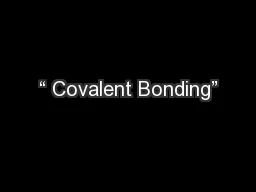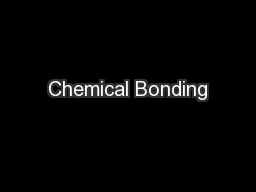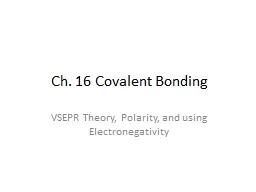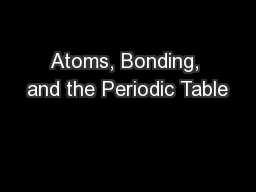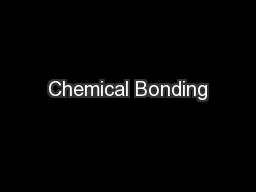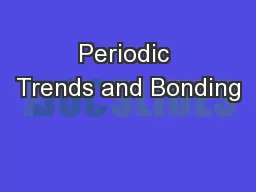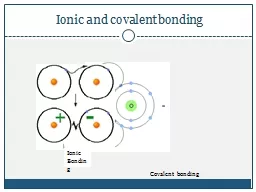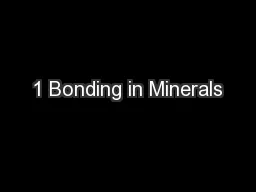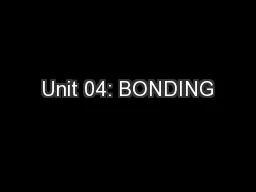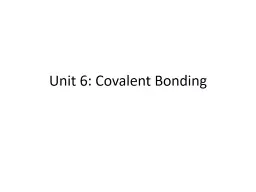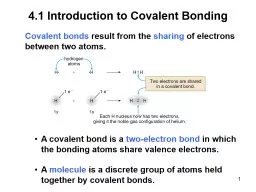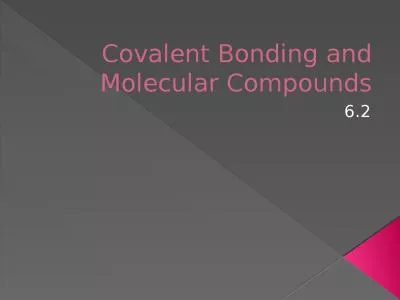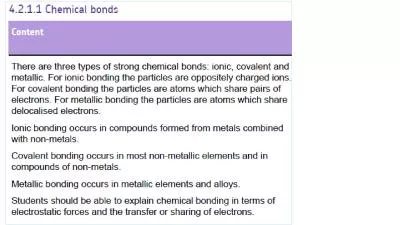PPT-“ Covalent Bonding”
Author : cheryl-pisano | Published Date : 2016-09-21
Ballandstick model Molecular Compounds OBJECTIVES Distinguish between the melting points and boiling points of molecular compounds and ionic compounds Molecular
Presentation Embed Code
Download Presentation
Download Presentation The PPT/PDF document "“ Covalent Bonding”" is the property of its rightful owner. Permission is granted to download and print the materials on this website for personal, non-commercial use only, and to display it on your personal computer provided you do not modify the materials and that you retain all copyright notices contained in the materials. By downloading content from our website, you accept the terms of this agreement.
“ Covalent Bonding”: Transcript
Ballandstick model Molecular Compounds OBJECTIVES Distinguish between the melting points and boiling points of molecular compounds and ionic compounds Molecular Compounds OBJECTIVES. and . Electronegativity. Presented by . Leticia Bonita Prince. Newcastle University 4. th. Year . MChem. Student. Aims of Today. Increase your understanding of bonding and electronegativity. Increase your spatial skills and awareness using software designed by the CCDC. Introduction to Chemical Bonding. Introduction to Chemical Bonding. Objectives:. Define . chemical bond.. Explain why most atoms form chemical bonds.. Describe ionic and covalent bonding.. Explain why most chemical bonding is neither purely covalent nor purely ionic.. VSEPR Theory, Polarity, and using . Electronegativity. Covalent . Bonds. Forms when 2 atoms share a pair of valence e. -. A. Types of Covalent Bonds. 1. . Single Covalent Bond . – two atoms share . Valence Electrons and Bonding. The number of valence electrons (electrons in the outermost energy level) in an atom of an element determines many properties of that element, including the ways in which the atom can bond with other atoms.. . and Structure. IB Chemistry. Topic 4. . Bond - A force that holds . atoms . together and . makes . them . function as a . unit.. 4.1 Ionic Bonding. An . ion. is a charged particle. Ions form from atoms or from groups of atoms by . Higher Supported Study - Week 2 . Key Areas – Periodic Trends . The trends in . covalent radius . across periods and down groups.. The trends in . ionisation energies . across periods and down groups. . Covalent bonding. Ionic bonding. Ionic Bonding. Bonding as you’ve never imagined it. http://www.youtube.com/watch?v=BCYrNU-7SfA. Objectives. To consider the features of ionic and covalent bonds, and the compounds they make. The Glue That Holds Minerals Together . GLY . 4200 – Fall. , 2016. 2. Types of Bonds. Intramolecular. Ionic. Covalent. Metallic. Intermolecular. Hydrogen. Van der Waals. 3. Definition of Bonding. A chemical bond is an attraction between atoms brought about by:. IB Topics 4 & 14. Text:. Ch 8 (all except sections 4,5 & 8). Ch 9.1 & 9.5. Ch 10.1-10.7. My Name is Bond. Chemical Bond. PART 5: Giant Covalent Structures, Metallic Bonding & Physical Properties. Covalent Bonding. A . chemical bond . is the force that holds two atoms together and makes them function as a unit. Atoms form bonds to become most stable and obtain an octet. Covalent Bonding: Electrons are shared between two or more elements. Always between 2 non-metals. Covalent bonds . result from the . sharing . of electrons. between two atoms.. A covalent bond is a . two-electron bond . in which the bonding atoms share valence electrons.. A . molecule . is a discrete group of atoms held together by covalent bonds.. Do . Now: Identify . Bond Type from Formula. Au. Ag. CO. 2. Li. 3. N. Na. 2. S. Mg. CsF. H. 2. O. NaCl. SO. 2. Cu. CH. 4. Covalent. Covalent. Covalent. Covalent. Ionic. Ionic. Ionic. Ionic. Metallic. 6.2. Molecules. Molecules – a neutral group of atoms held together by . covalent. bonds. Molecular compound – a . cmpd. whose simplest units are molecules. Chemical formula – indicates relative # of atoms of each kind in a chemical compound by using atomic symbols & subscripts. Ionic bonds form a . giant lattice structure. Sodium chloride is an ionic compound formed by the reaction between the metal sodium and the non-metal chlorine.. During the reaction, one electron is transferred from each sodium atom to each chlorine atom..
Download Document
Here is the link to download the presentation.
"“ Covalent Bonding”"The content belongs to its owner. You may download and print it for personal use, without modification, and keep all copyright notices. By downloading, you agree to these terms.
Related Documents

